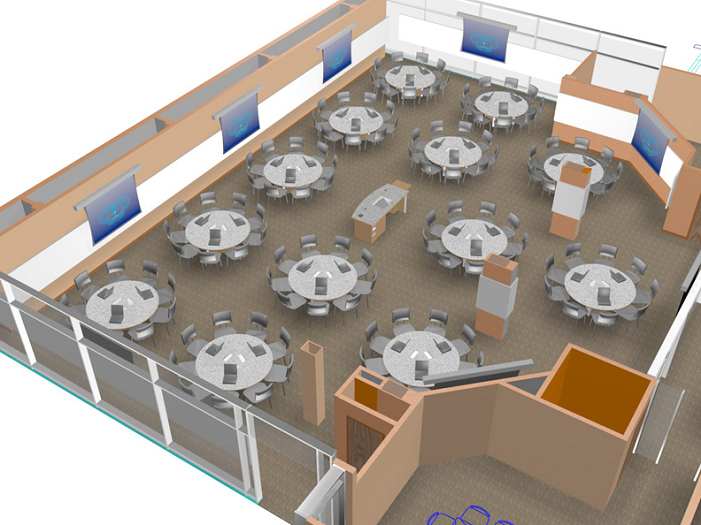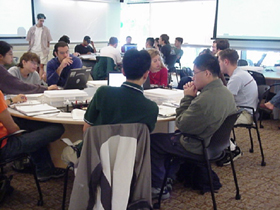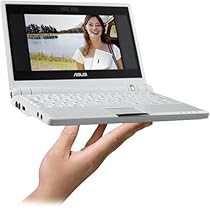
The
MIT iCampus seminar in Canberra 12th July was worthwhile.
Philip Long talked about the experience at MIT and
Mark Schulz about the
iCampus implementation at University of Queensland. iCampus provides a number of computer aided teaching systems, some used in a classroom and some remotely. Many of the ideas behind iCampus look directly applicable in Australia, without necessarily using MIT's Microsoft based software or applications. I had to leave part way through but here are my notes on the talk:
The emphasis of the presentation was on teaching physics, as that is a priority at MIT, but the techniques could be applied to other sciences and the humanities. Also this seemed to be for introductory first year courses, which previously were conducted using live lectures with hundreds of students in the room. But I could see the same techniques applied to high level university courses and industry courses, such as the one ANU is preparing for senior government people on e-archiving.
Philip
induced the talk explaining that MIT had OpenCourseWare which was essentially online free publishing of course content. While a useful resource and more you get from a textbook, the OpenCourseWare provides only limited interaction, not a whole course.
TEAL
The first technology explained was TEAL (Technology Enabled Active Learning). This provides a combination of mini lectures and lab sessions in the one nightclub style room.
 The MIT TEAL leaning rooms are 3,000 square feet (279 square metres), with 13 round tables with nine students each, working in teams of three (one computer per team). The square room has
The MIT TEAL leaning rooms are 3,000 square feet (279 square metres), with 13 round tables with nine students each, working in teams of three (one computer per team). The square room has 13 writing boards and eight video projection
screens. The presenter stands in the middle of the room at a workstation with cameras, computers and experimental equipment. The students can watch on screens around the walls. As this is for physics, the students have actual lab equipment on the table in front of them.
One interesting comment was a return to blackboards, as they can be videoed better than whiteboards (no mention was made of electronic whiteboards). Each student has a "clicker" for student feedback (a hand held TV remote control type device). The clicker is mostly used to gauge student understanding so the content can be adjusted, but can also be used for some assessment.
Apart from the lecturer, there are two teaching assistants (graduate students) in the room to assist. The room can hold up to 117 students, but usually 80 is preferred. There is also a technical support person available to fix computers.
Philip
claimed that seven foot diameter circular tables with three groups of three students had been found to be optimal (I wonder if there is a human factors reason why this is also the size of a broad gauge railway and about as big as you can fit in an ISO shipping container). The student groups are fixed for half a semester as the aim is to give students experience in working in groups. The "clicker" devices are used to record attendance.
 University of Melbourne use double wedge shaped tables, which allow teachers to stand in the wedge gaps, close to the students. The Unviersity also has detailed Teaching Space Design Guidelines
University of Melbourne use double wedge shaped tables, which allow teachers to stand in the wedge gaps, close to the students. The Unviersity also has detailed Teaching Space Design Guidelines, including designs for lecterns and a discussion of
Collaborative Learning Spaces (including the Cecil Scutt, Alice Hoy, Podium and Boardroom models).
The usual MIT TEAL session is a two hour block, starting with a review of the previous day's work, a mini-lecture with the teacher walking around the room, lab and a quiz.
Philip
claimed research showed TEAL produced better results than the best lecturer in a traditional lecture theater. The environment was particularly good for helping the poorer performing students. The system was also beneficial for retaining groups who may have been disadvantaged by traditional teaching methods, including females and Native Americans.
I asked about the relative cost of the system: more hands-on learning may be better for the students, but it usually requires more hand for the teaching and costs a lot more to provide. Philip
said it was neural in staff costs. There is a high initial capital cost. There was a also several years of effort needed to change the learning materials. The change also caused some resistance from staff and students used to traditional lectures. Some changes made in response to the new system were to reduce the amount of "Powerpoint" used and new staff were required to gain experience as teaching assistants for two session before being permitted to present.
Philip
suggested that six to eight "star" lectures are needed to give the students the sense that they are getting their money's worth of being at a "real" university. However, the students achieved better results from the online learning, even if they did not appreciate it as much.
iLabs
iLabs provides online access to experiments (or what I would call "demonstrations" not "experiments"). Providing web based experiments requires an infrastructure. MIT does this using a service broker to grant access to specific experiments. The student can then interact with a real physical experiment at MIT using the web interface.
The one demonstrated was a transistor, setting and measuring voltages. Philip
commented that webcams and microphones are set up to show a live images and sounds of the experimental equipment. This does not show much actually happening, but reassures the student that this is a real experiment. The students then go on to do experiments with real circuits. However, the students benefit from first having tried the online version and it can handle tens of thousands of users.
The interface shown was a Java program and I was unable to comfortably read the text on the screen. MIT need to modify the interface to allow the text size to be changed and provide other accessibility features (as required by US and Australian law). It might also be fun to get it to work on an iPhone.
Unfortunately I had to leave and so missed discussion of xMas Cross Media Annotation System, which provides a way to provide annotation of online content using different formats and the SLP Spoken Language Processor, which indexes audio and video content using keywords.
iCampus applied in Australia?
Australian TEAL
The techniques for TEAL sound very appealing to me, the actual implementation by MIT less so. Giving lectures to a large room full of students is not a pleasant experience for me (and I suspect not for the students either). With up to 100 in the class there is very limited scope for interaction. The danger is that as more of the content have been placed on the web, dull non-interactive lectures will be replaced with dull non-interactive online content. The TEAL approach provides a way to counteract that and fits with the latest research based ideas on education. It should be possible to blend online and face to face learning, but this needs to be as efficient, in terms of cost and staff time as existing methods to be practical.
The University of Melbourne
guidelines recommend 2 square metres per student for a "Cabaret-Style" Collaborative Learning room. This is less than the 2.38 sq m per student for the MIT TEAL room and half the 1 sq m per student UoM specify for a lecture theater (1.5 sq m for a tutorial). An ANU course, such as "
Information Technology in Electronic Commerce " (COMP3410), has 31 hours of lectures and 14 hours of tutorial/laboratory sessions. Assuming the recommended UoM floor areas are used, this would require an average of 1.16 sq m per student per hour, less than half that of the MIT TEAL room.
Unless the TEAL rooms can be used more efficiently than conventional lecture and tutorial rooms, twice as much floor space would be needed. However, as the TEAL rooms have flat floors and ordinary tables, they may be able to be used more flexibly than raked floor lecture theaters. While the electronic equipment for the rooms will add to the cost, using single story flat floor rooms may make them cheaper than lecture theaters.
The MIT TEAL system uses dedicated, fixed size rooms. Systems with movable room dividers, as commonly used in commercial convention centers might be used to divide one TEAL room into several smaller tutorial rooms. Rooms may also be made multi propose, providing study space for students, or computer labs, when not needed for classes. This could replace some of the study space now commonly provided in university libraries.
Merging online and face to face education
My ACS Professional Development Board provides postgraduate education for IT professionals, using the Australian Moodle system. This uses online tutorials and interactive learning. However, it lacks any face to face component.
I used my own installation of the Moodle system for a one day commercial industry course on writing for the web with 24 students. This has the students in groups of two sharing a PC. The students sat at two horseshoe shaped rows of 12, with myself and a projection screen at the focus. This just happened to be the arrangement which the organization's trainers usually used for live courses and I adapted for blended online/live training. It worked very well and was intending to use at ANU.
ANU Computer Science is considering reequipping one of its rooms as an electronic leaning lab. The design is similar to the TEAL floor plan. I dubbed this "Project Trocadero", as the floor plan is similar to a nightclub. One issue is how much all the equipment gets in the way of the person to person interaction. An interactive projection screen was proposed, but given MIT's reversion to chalk boards, does not seem a priority. One approach would be to make as much of the equipment as possible wireless, to allow easy rearrangement. The walls could be covered with full height lockable cabinets to conceal cables, hold electronics (as in the "Office in a Box" design for my Smart Apartment home office). Cupboard doors could be surfaced to act as black and white boards with electronic screens attached with VESA Mounts or simply bolted to the doors.
It would be possible to build a low cost transportable version of such a room. WiFi communications to wireless, battery powered devices could be used. That could mostly consist of laptop computers. The large wall screens could be LCD TVs, with the video signal transmitted to them. Thin client workstations, preferably running Linux, are another option. Those needing Microsoft Windows applications could use Citrix or similar, as used at the new
State Library of Queensland. Wireless thin clients could be simply fixed to the backs of LCD panels.
Australian iLabs
The idea of online experiments could be applied beyond the hard sciences. For teaching web design in the ANU's Networked Information Systems course I found TAW (Web Accessibility Test), from the
CTIC Foundation in Spain to be very useful. For teaching
metadata in the ANU's
IT in e-Commerce course, the
Reg and Reggie tools deveoped by the former Distributed Systems Technology Centre (
now mantained by Metadata.Net) were useful. These tools were used on live web sites, adding an element of realism to the exercises.
Labels: e-Learning, iCampus, MIT, Shipping Container, Thin Client Computing












